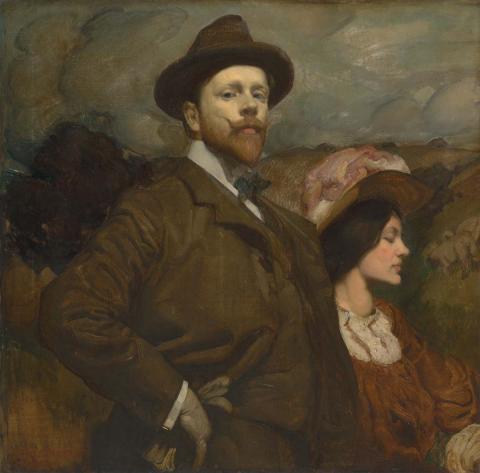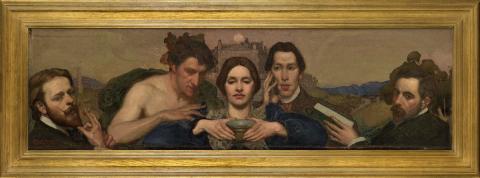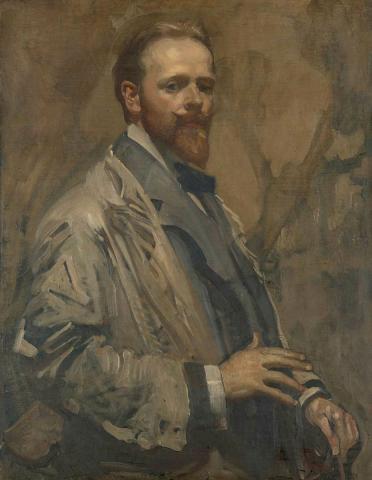George W Lambert
By Victoria Garton
September 1999
1873, St Petersburg, Russia – 1930, Cobbity, NSW
George Washington Thomas Lambert, commonly known as GW Lambert, was born in 1873 in St Petersburg, Russia. His father, an American railway engineer, died shortly before his birth. Along with his mother and three elder brothers, Lambert moved soon after his birth to live with relatives in Germany. The family moved again to England in 1881, where Lambert underwent his schooling, before they finally immigrated to New South Wales in 1887.
After working for several years as a station hand on his great-uncle's property at Eurbola, Central New South Wales, Lambert became a grocer's clerk in Sydney. He enrolled in art classes run by Julian Ashton under the auspices of the Art Society of New South Wales and for some years shared a studio with Sydney Long. When in 1895 Julian Ashton began his own art school, the Academie Julian, Lambert followed him. Later in his career, Lambert is reputed to have been considered by Ashton as his greatest triumph as a teacher. In 1895 Lambert also began contributing drawings to the Sydney 'Bulletin', and exhibiting with the New South Wales Society of Artists.
Lambert excelled in his studies, and in 1899 won the Wynne Prize for landscape with one of his most important paintings, 'Across the Black Soil Plains' (AGNSW). In 1900 Lambert was the recipient of the first New South Wales Travelling Scholarship for artists. Soon afterwards he left Australia for Europe with his new wife, Amelia (Amy) Absell, enrolling at Colarossi's in Paris along with fellow Australian Hugh Ramsay. After working successfully in Paris for one year, Lambert and his young family moved to England, where his success continued to grow.
The family eventually settled in Chelsea until the First World War. During these pre-war years in England Lambert exhibited frequently at the Royal Academy and New Salon. He was a member of the Chelsea Arts Club, an associate of the New Salon, a council member of the International Society of Painters and Gravers, and a founding member of the Modern Society of Painters. Lambert supplemented his income in various ways throughout this period, contributing sketches to the Sydney 'Bulletin' and various other publications in England and Australia, until giving up illustrative work in 1909. In the same year he became a teacher at the London School of Art.
As a specialist in portraiture Lambert was able to make an income through commissions from subjects as important as King Edward VII; however, many of his portraits were uncommissioned paintings and sketches of his own family and friends. During the First World War he became a very successful and prolific war artist with the Australian Light Horse Brigade in Palestine from 1917 until 1920.
By the time he and his family decided to return to Australia in 1921, he was being hailed as one of the art world's most important artists. In 1922 he was elected an associate of the Royal Academy in London. Released from his duties as a war artist, Lambert once again specialised in portraiture. He continued to exhibit with the Society of Artists, and from 1926 with the Contemporary Group which he formed with Thea Proctor. He worked together with Sydney Ure Smith to help keep the outlook of the Society of Artists liberal, and to ensure the support of young artists.
Lambert died in 1930 at Cobbity, New South Wales, at the age of 57.
Victoria Garton, former Curatorial Assistant, QAGOMA.
Bibliography
- Anne Gray, George Lambert 1873–1930 Catalogue Raisonne, Bonamy Press, Canberra, 1996, pp.iii–xi.
- Alan McCulloch and Susan McCulloch, The Encyclopedia of Australian Art (Revised and Updated), Allen & Unwin, Sydney, 1994, p.410.
- Bede Nairn and Geoffrey Serle, Australian Dictionary of Biography Vol. 9 (1891–1939) Gil–Las, Melbourne University Press, Melbourne, 1983, pp.649–50.


